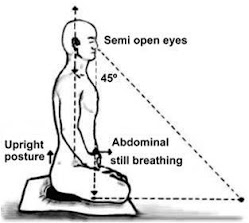Understanding the Process
There are steps that must be learned in proper Qi Gong breathing. All of these steps work in concert with each other. The steps which are outlined in this article will help you absorb the most out of the air you breath. Each step helps maximize the amount of time your lungs are exposed to the life giving elements in air, these steps also help increase the surface area you have in your lungs to absorb these elements into your blood stream.
Let’s start with a picture, since it is much easier to show posture than it is to explain it.
You want your head over your hips and your spine straight but relaxed. This can be kneeling, cross legged or seated in a chair.
The Four Stages of Breath
Inhale
Condense
Exhale
Pause
Inhalation should begin with empty lungs and flared nostrils. Fill your navel area first. Think of filling your lungs like pouring water into a cup, the bottom fills first. Do not make the mistake of many people beginning Qi Gong and only try to fill the bottom. Continue to fill the middle and upper portions of your lungs as well. Do not over fill your lungs, comfortably fill them. The idea is to expose the entire surface area of your lung to the air you inhale.

Condensing the air in your lungs is fairly simple. Just slightly push it downward toward your navel and imagine energy being absorbed through the lung and into the body.
Exhale the air in your lungs smoothly, and again, with flared nostrils. There should be a smooth transition between each phase. Make sure you exhale the lower sections of your lungs, but do not force the air out, just let it happen. If you are in a rush to inhale you’ve condensed the air for too long.
A pause should happen at the end of each breath. This makes your blood circulate and removes stagnation. Take this time to check your posture and relax your abdomen for the next breath.
The Locks
The Lower Lock
The Throat Lock
The Abdominal Lock
 These techniques are considered locks in terms of energy, but they are more contractions from a purely physical view. It is very important to apply these locks because they help you look inwardly. They also help you condense the energy you are harvesting from the air, and seal them from leaking out. Each lock has it’s own place in between a stage in the four stages described above.
These techniques are considered locks in terms of energy, but they are more contractions from a purely physical view. It is very important to apply these locks because they help you look inwardly. They also help you condense the energy you are harvesting from the air, and seal them from leaking out. Each lock has it’s own place in between a stage in the four stages described above.
The Lower lock, also called the anal lock, is the first lock to be applied during Qi Gong Breathing. Apply this lock as you begin to reach a comfortable capacity for your inhalation. You should tighten the outer ring of the anal sphincter, which will stimulate the nerves of the sacrum. This is your first step in stimulating the Qi to raise from the sacrum to the brain. It is also important because this provides a firm foundation for breath compression.
The throat lock is applied when you have reached a comfortable full inhalation . This is nice and simple, all you need to do is simulate swallowing. This will stop any air from leaking out from the upper portions of your lungs. Also, this will provide a firm ceiling for your breath compression.
The abdominal lock is simple as well, all you need to do is relax your abdominal muscles and draw your navel in slightly toward the spine. This step is the last in the three locks, it is also the most important. In building up your internal energy you should focus on your lower abdomen, or Dan Tien in Chinese.
 These processes could easily be compared to compressing a large pile of shredded paper. You want to take something that is light and thin, and compress it into something solid and strong. Again, this all seems complicated when you start but after a few weeks or months it becomes natural and easy. My teacher likened many of these processes to driving a car. At first you need to clutch, shift, brake and check your mirrors, but soon it becomes natural.
These processes could easily be compared to compressing a large pile of shredded paper. You want to take something that is light and thin, and compress it into something solid and strong. Again, this all seems complicated when you start but after a few weeks or months it becomes natural and easy. My teacher likened many of these processes to driving a car. At first you need to clutch, shift, brake and check your mirrors, but soon it becomes natural.
Yours,
David
If you want lots more great information regarding health, happiness and longevity sign up for our FREE NEWSLETTER BY CLICKING HERE!


